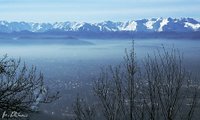Travel Turin, Italy
Travel Turin, Italy
Turin, Italy is the host of the 37th Chess Olympiad and it will start on 20th May to 4th June. Here's some of the information of Turin taken from Wikipedia, the free encyclopedia.
Turin (Italian: Torino; Piedmontese: Türín) is a major industrial city in north-western Italy, capital of the Piedmont region, located mainly on the west bank of the Po River. The population of Turin city is 908,000 (2004 census), but with its metropolitan area totals about 1.7 million inhabitants. The province is one of the largest in Italy, with 6,830 square kilometres (2,637 sq. mi), and one of the most populous, with 2,236,941 inhabitants at the 2004 census. Turin is also well-known as the home of the shroud of Turin and host of the 2006 Winter Olympics.
History
The name of Turin comes from Tau, a Celtic word that means mountains. Its Italian name, Torino, translates as "little bull"; hence the coat of arms and the symbol of the city. The area was settled by the Taurini in pre-Roman times.
In the 1st century BC (probably 28 BC), the Romans created a military camp (Castra Taurinorum), later dedicated to Augustus (Augusta Taurinorum). The typical Roman street grid can still be seen in the modern city. Turin reached about 5,000 inhabitants at the time, all living inside the high walls.
After the fall of the Roman empire the city was conquered by the Lombards, then the Franks; in 942 the Contea di Turino, i.e. Countship of Turin, was founded, since 1050 held by the family of the (then) Counts of Savoy. While the dignity of count was held by the Bishop as conte di Turino, 1092-1130 and 1136 - 1191, it was ruled as a prince-bishopric by the Bishops. It was a lordship 1230 - 1235 under the Marchese di Monferrato, styled Signore di Torino ('Lord')
At the end of the 13th century, when it was annexed to the Duchy of Savoy, the city already had 20,000 inhabitants. Many of the gardens and palaces were built in the 15th century when the city was redesigned. The University was also founded during this period.
Emanuele Filiberto (Iron Head) made Turin the capital of the Duchy of Savoy in 1563. Piazza San Carlo, via Po and the Royal Palace (Palazzo Reale) were built in this period.
In 1706 the French besieged the city for 117 days without conquering it (Battle of Turin). After the subsequent Treaty of Utrecht, the Kingdom of Sardinia was annexed to the Duchy of Savoy and the architect Filippo Juvarra began a major redesign of the city. Now the capital of a European kingdom, Turin had about 90,000 inhabitants at the time.
In the 19th century, after brief occupation by Napoleon, the city began to actively pursue the unification of Italy. In 1871, the Fréjus Tunnel was opened, making Turin an important communication node. The city now had 250,000 inhabitants. The Museo Egizio, the Mole Antonelliana, the Gran Madre church and Vittorio Veneto square were built in this period.
In 1861, Turin became the capital of the newly proclaimed United Italy. In 1865 the capital was moved to Florence. (Since 1870 the capital has been Rome.) Turin reacted to the loss of importance by beginning a rapid industrialisation: in 1899 FIAT was founded and Lancia in 1906. The Universal Exposition held in Turin in 1902 is often considered the pinnacle of Art Nouveau design, and the city hosted the Exposition again in 1911. By this time, Turin had grown to 430,000 inhabitants.
After World War I conflicts between workers and industrialists began. The first strikes took place and in 1920 the Lingotto factory was occupied.
After World War II Turin was rapidly rebuilt and its industries greatly developed, which caused waves of immigration, largely from the southern regions of Italy. The population reached 1 million in 1960 and peaked at 1.5 million in 1975. In the 1980s the first industrial crisis hit the city and its population began to decline (and continues to, while the metropolitan area grows). The 2005 population is 908,000.
Turin also has one of the worlds largest football clubs that is supported by a large number of Italians. Juventus F.C have always had a fierce rivalry with the Milan football club who is another massively supported team in the Serie A. Alessandro Del Piero is one of the most beloved players for Juventus and was born and bred in the town of Turin.




0 Comments:
Post a Comment
<< Home